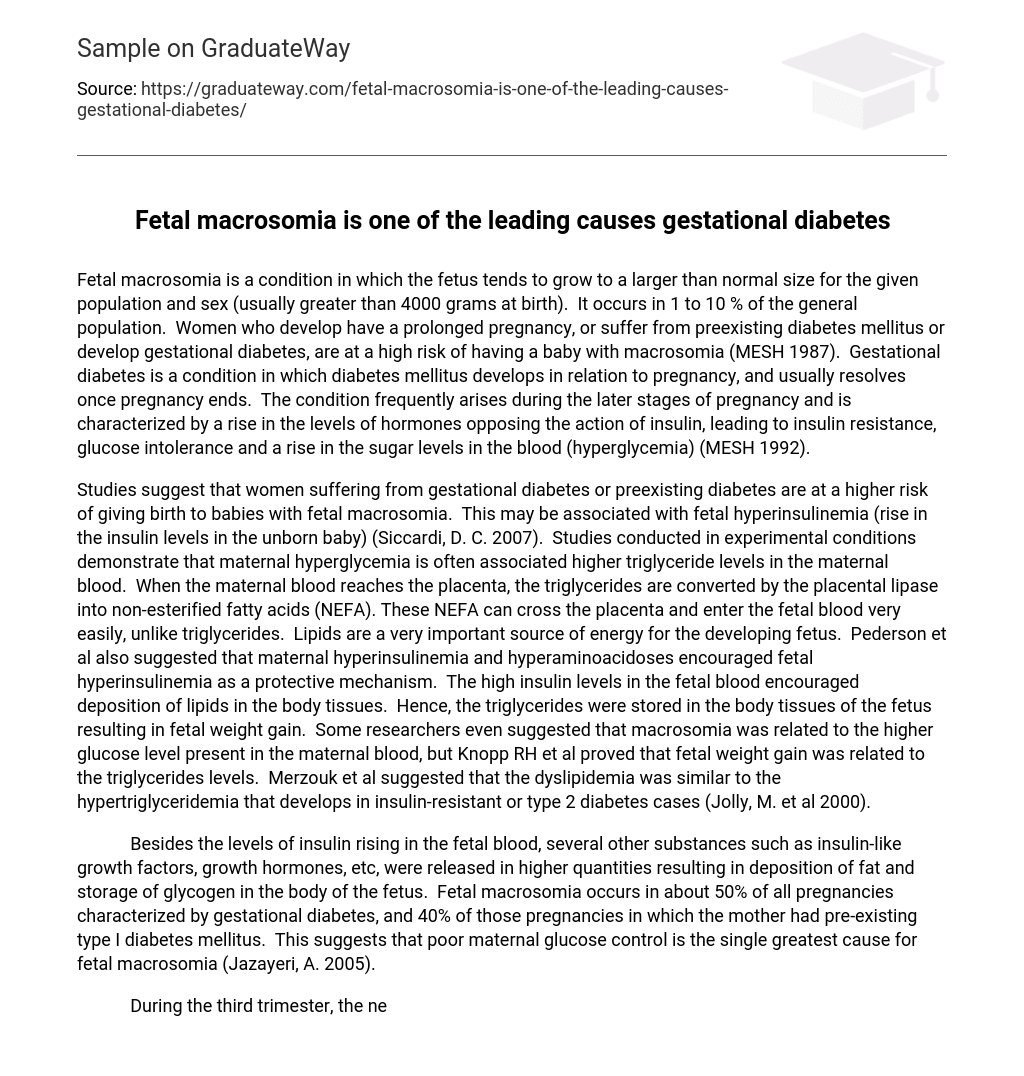Fetal macrosomia is a condition in which the fetus tends to grow to a larger than normal size for the given population and sex (usually greater than 4000 grams at birth). It occurs in 1 to 10 % of the general population. Women who develop have a prolonged pregnancy, or suffer from preexisting diabetes mellitus or develop gestational diabetes, are at a high risk of having a baby with macrosomia (MESH 1987). Gestational diabetes is a condition in which diabetes mellitus develops in relation to pregnancy, and usually resolves once pregnancy ends. The condition frequently arises during the later stages of pregnancy and is characterized by a rise in the levels of hormones opposing the action of insulin, leading to insulin resistance, glucose intolerance and a rise in the sugar levels in the blood (hyperglycemia) (MESH 1992).
Studies suggest that women suffering from gestational diabetes or preexisting diabetes are at a higher risk of giving birth to babies with fetal macrosomia. This may be associated with fetal hyperinsulinemia (rise in the insulin levels in the unborn baby) (Siccardi, D. C. 2007). Studies conducted in experimental conditions demonstrate that maternal hyperglycemia is often associated higher triglyceride levels in the maternal blood. When the maternal blood reaches the placenta, the triglycerides are converted by the placental lipase into non-esterified fatty acids (NEFA). These NEFA can cross the placenta and enter the fetal blood very easily, unlike triglycerides. Lipids are a very important source of energy for the developing fetus. Pederson et al also suggested that maternal hyperinsulinemia and hyperaminoacidoses encouraged fetal hyperinsulinemia as a protective mechanism. The high insulin levels in the fetal blood encouraged deposition of lipids in the body tissues. Hence, the triglycerides were stored in the body tissues of the fetus resulting in fetal weight gain. Some researchers even suggested that macrosomia was related to the higher glucose level present in the maternal blood, but Knopp RH et al proved that fetal weight gain was related to the triglycerides levels. Merzouk et al suggested that the dyslipidemia was similar to the hypertriglyceridemia that develops in insulin-resistant or type 2 diabetes cases (Jolly, M. et al 2000).
Besides the levels of insulin rising in the fetal blood, several other substances such as insulin-like growth factors, growth hormones, etc, were released in higher quantities resulting in deposition of fat and storage of glycogen in the body of the fetus. Fetal macrosomia occurs in about 50% of all pregnancies characterized by gestational diabetes, and 40% of those pregnancies in which the mother had pre-existing type I diabetes mellitus. This suggests that poor maternal glucose control is the single greatest cause for fetal macrosomia (Jazayeri, A. 2005).
During the third trimester, the need for nutrients by the fetus is very important, and a rise in the maternal glucose levels can cause several ill-effects on the fetus. Most of the pregnant women who develop gestational diabetes (90 %) either have reduced number of insulin receptors or an increase in the body fat in the abdominal area. The remaining 10 %, develop gestational diabetes due to insufficient production of insulin. The insulin receptor shortage may develop due to the action of certain insulin antagonist (such as HPL). Studies have shown that the level of HPL rises in direct proportion with the duration of pregnancy. The maternal pancreas may further release higher amounts of insulin in the blood, in an effort to reduce the blood glucose levels. However, the insulin produced further reduces the number of insulin receptors (Siccardi, D. C. 2007).
A study was conducted between January 1, 1995, and December 31, 2001in St. Paul’s Hospital on mothers who developed gestational diabetes during their pregnancy. About 394 babies were studied in the case group, and compared to 100 babies in the control group. The occurrences of Caesarean operations, larger babies and gestational hypertension were higher in the gestational diabetes group. This suggests that the risk of complications for the mother and the child were greater in mother’s having gestational diabetes (Johns, K. et al. 2006). In another study, the risk of complications in neonatals was about 3 to 9 times greater in those born from diabetic mother, compared to non-diabetic (Yang, J. et al. 2006).
References:
Allahyar Jazayeri. “Macrosomia.” Medical Topics. 2006. E-Medicine. 30 Jan. 2007. http://www.emedicine.com/med/topic3279.htm
Johns, K., Olynik, C., Mase, R., Kreisman, S., Tildesley, H. “Gestational diabetes mellitus outcome in 394 patients.” J Obstet Gynaecol Can 28.2 (2006): 122-127. http://www.ncbi.nlm.nih.gov/entrez/query.fcgi?db=pubmed&cmd=Retrieve&dopt=AbstractPlus&list_uids=16643713&query_hl=5&itool=pubmed_DocSum
Jolly, M., and Robinson, S. “The causes and effects of fetal macrosomia in mothers with type 1 diabetes.” J Clin Pathol 53 (2000): 889. http://jcp.bmj.com/cgi/content/full/53/12/889
Michael F. Greene. “Oral Hypoglycemic Drugs for Gestational Diabetes.” NEJM 343.16 (2000): 1178-1179. https://content.nejm.org/cgi/content/full/343/16/1178
Siccardi, D. C. “Gestational Diabetes.” Obstetrics and Gynaecology. 2007. MedStudents. 30 Jan. 2007. http://www.medstudents.com.br/ginob/ginob4.htm
Yang, J., Cummings, E. A., O’connell, C., and Jangaard, K. “Fetal and neonatal outcomes of diabetic pregnancies.” Obstet Gynecol 108.3 (2006): 644-650. http://www.ncbi.nlm.nih.gov/entrez/query.fcgi?db=pubmed&cmd=Retrieve&dopt=AbstractPlus&list_uids=16946226&query_hl=5&itool=pubmed_docsum





